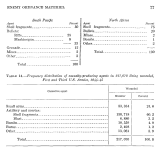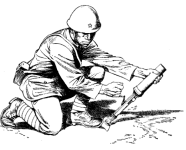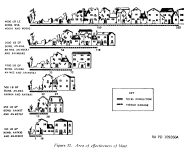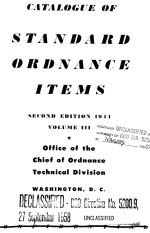BackworldTraveller
SOC-13
Nope - It's best to be somewhere nowhere near!Very interesting... so if someone fired a 75mm shell at you it is best to be directly in front of a low-angle impact!
Nope - It's best to be somewhere nowhere near!Very interesting... so if someone fired a 75mm shell at you it is best to be directly in front of a low-angle impact!
U.S. CASUALTIES CAUSED BY U.S. MISSILES
Of the 369 casualties in New Georgia and Burma, 66 (17.9 percent) were caused by U.S. fire, as were 219 (12.2 percent) of the 1,788 Bougainville casualties.
All types of weapons were represented, with rifle and artillery leading in both reports. It is doubtful that higher command is aware that U.S. soldiers killed and wounded such a large proportion of their fellow soldiers as these figures suggest. Accurate figures exist only for isolated reports, such as the reports for the Bougainville and the New Georgia-Burma campaigns.
There were a variety of reasons for this tragic situation: Individual carelessness, usually on the part of the men hit; poor training in the use of
weapons: poor unit discipline; lack of dissemination of information; poor leadership; and faulty judgment.
Limited experience suggests that artillery casualties were for the most part due to poor fire direction by inexperienced observers and also suggests that many casualties could probably have been prevented if adequate containers had been provided for grenades and if the length of safety time had been stamped on each grenade.
The majority of rifle and machinegun casualties occurred at night and were caused by mistaken identity. In most instances the casualty showed poor judgment-he stood up in his foxhole; moved about the perimeter; entered a perimeter without proper caution; or performed other foolish acts.
Nearly all rifle and machinegun casualties in the group hit by U.S. fire occurred when U.S. units were in defensive positions, in which there was little need for hasty decisions. The men should have had more confidence in camouflage and in their ability with specific weapons. Good communications and a general knowledge of the tactical situation would also have appreciably reduced the number of such casualties.
Most self-inflicted wounds were caused by carelessness and were not intentional.
I have airburst fragment patterns as well. However, if a projectile detonates on the ground, the fragment pattern along the track of the projectile if forward at an upward angle and spreading out. The result is a fragment "dead zone" near the burst, where there are an insufficient number of fragments for adequate wound coverage. Burst short of the target do less fragment damage than those that are over the target.I'm thinking air burst.
Going by the angles I see of gun/howitzer barrels being fired in Ukraine, if it hits the ground, the majority of the explosion, I would suppose, would be forward.
CAUSATIVE AGENTS OF BATTLE CASUALTIES IN WORLD WAR II
In order to determine which type of enemy weapon was most effective against U.S. troops in World War II, it would be necessary to know the causative agent for each wound inflicted. Not only was such information impossible to get for all areas for the entire war period but what was available was often inaccurate. Casualties who survived were frequently not able to determine the weapons that had wounded them. For those killed outright or who died of wounds, no opinion was available if there had been no witnesses. Prompt interment of bodies seldom left time for recovery of the missile that killed. Casualty surveys which supplied this type of information were made only in certain areas at specified times. However, these studies used different methods of reporting, and the lack of a uniform system made assessment and comparison of reports difficult.
Nevertheless, many interesting facts can be brought out from the material available. A report on the causative agents of battle casualties in World War II showed the comparative incidence of casualties from different types of weapons for several theaters. Compilers of the report believed that, while the more detailed subdivisions within their three major classes were open to question, their findings on the percent of total casualties due to small arms, artillery and mortars, and "miscellaneous" were reasonably accurate. From these they drew the following conclusions:
1. Small arms fire accounted for between 14 and 31 percent of the total casualties, depending upon the theater of action: The Mediterranean theater, 14.0 percent; the European theater, 23.4 percent; and the Pacific theaters, 30.7 percent.
2. Artillery and mortar fire together accounted for 65 percent of the total casualties in the European and Mediterranean theaters, 64.0 and 69.1, respectively. In the Pacific, they accounted for 47.0 percent.
The report showed the relative effectiveness of causative agents which inflicted casualties on 217,070 living wounded of the First and Third U.S. Armies, European Theater of Operations, 1944-45 (table 14).
It is also interesting to note from two tables taken from studies conducted on Bougainville and in Italy that more casualties in the South Pacific were caused by rifle or machinegun fire than in the North African theater:


That is just the 1st and 3rd Armies in Europe. That does not include the 9th Army, the 7th Army, or the 15th Army which also fought in France and Germany, not the 5th Army which was fighting in Italy. The U.S. Army had over 3 million men in Europe when the war against Germany ended.217,000 wounded in a single year, for, I assume, just the US. It's still difficult to grasp the scale of what went on during WWII.
As the comfort and efficiency of the ship, not to mention the Captain’s peace of mind, depend on the First Lieutenant, the Captain as a rule takes good care to pick his own man. Here are a few of the First Lieutenant’s duties. He must act as a strainer between the Captain and the ship; holding back the unessential, passing on the vital. That is to say, he must be a subtle and discriminating editor. He must make all his arrangements; for the ordering and disposition of every soul aboard, through the next day, week or month; with the cheerful foreknowledge that the bulk of them will be knocked into a naval cocked hat by the exigencies of the service. He must then retire into himself with a pack of printed cards, one for each man, and work out the whole puzzle afresh. At the same time he must not allow his own irritation to affect his dealings with the Wardroom, whose official head he is, and whose members are (a) his subordinates, and (b) gentlemen of leisure assembled of an evening for a quiet rubber. He must get the utmost out of them, not by the menace of his authority, because that means a smash-up sooner or later, but because of their genuine liking for him as an individual. The Wardroom is young, very male, and unable to avoid meeting itself every day and all day long. You will concede that a certain amount of tact may be necessary in handling it? He must, further, see with those eyes which he is authorised to wear at the back of his head, that no warrant or petty officer, no ship’s corporal, or master-at-arms is abusing authority to spite some man or boy. He must still further see that no official, yielding to a natural desire for popularity, is quietly letting down the discipline of the lower-deck. He must know the Captain’s mind seventeen and two-thirds seconds before the Captain opens his mouth, because he will need that time to think out arrangements to meet the order. He must be the soul of rectitude and honour, but he must grasp the inwardness and frustrate the outwardness of every trick and trap sprung on him twenty times a day. In the Captain’s absence he is the visitors’ host and chaperone, and as visitors in harbour may range from Royalty to ragamuffins, his manners must be in the widest sense of the word, adaptable. Finally, at all crises, where the “blue” goes there must he lead: leaping the larger abyss; standing nearer to the danger; walking the more slippery foothold, passively enduring longer the exposure; and through it all he must keep the cool eye and balanced head of authority.
And the public is surprised when a naval officer proves that he is a diplomat!
Hmm, it was his last command and just months before Patton’s death.As I recall Patton headed up a postwar committee that looked at these sorts of numbers and experiences to help determine the form of the future army. Should be plenty of usable stats in that summary.


Given that they are showing damage to houses and the bomb size is given in LBs, I assume the scale for distance is in feet.What is the distance scale?
My apologies, Mike, for not including the scale, which is in feet. The data comes from a 1948 analysis of weapons performance.What is the distance scale?
As I understand it there are other factors to consider in modeling a bomb or artillery shell, such as casing and shrapnel.Would there be interest in my digging out that manual and giving the blast radius adjustment for various explosive loading?
By the way, this blast coverage, aside from adjustments based on explosive loading, is still valid. That is why I have problems with the weapon effects design sequence for MegaTraveller. You simply cannot endlessly increase effective blast and casualty radius at a given weight of shell or bomb.
Yes, that would be greatly appreciatedWould there be interest in my digging out that manual and giving the blast radius adjustment for various explosive loading?
By the way, this blast coverage, aside from adjustments based on explosive loading, is still valid. That is why I have problems with the weapon effects design sequence for MegaTraveller. You simply cannot endlessly increase effective blast and casualty radius at a given weight of shell or bomb.



